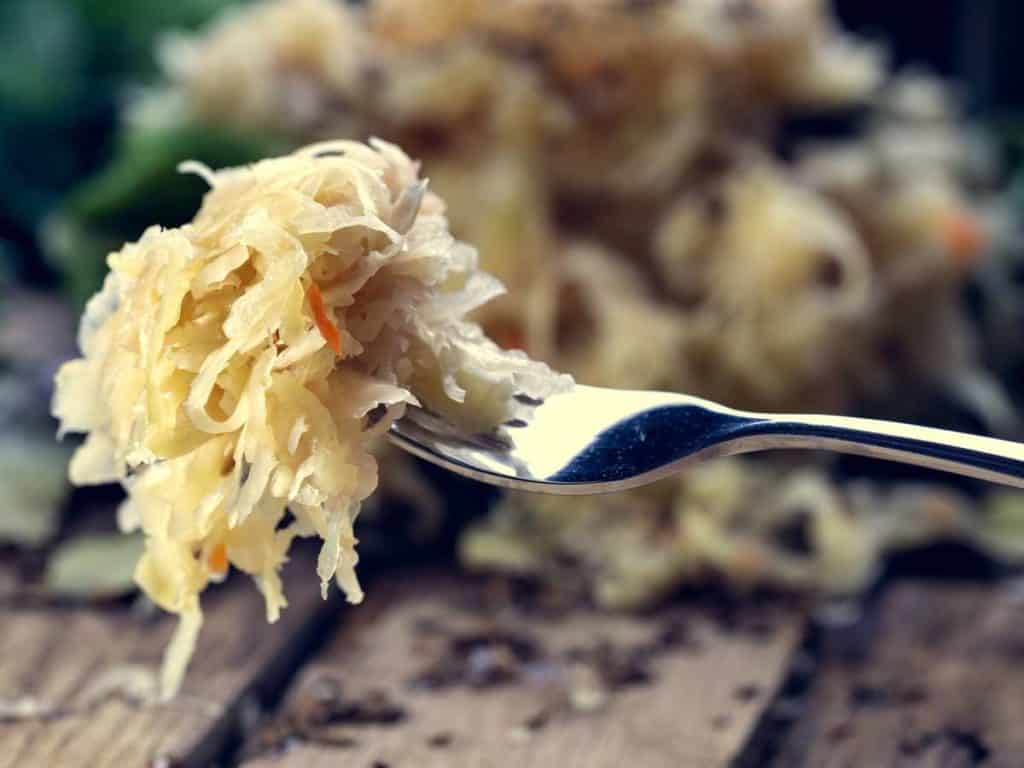Use These 9 Ingredients to Improve Store-Bought Sauerkraut Taste
Sauerkraut is made from finely cut raw cabbage that has been fermented by various lactic acid bacteria. It has a long shelf-life and a unique sour flavor, which results from the lactic acid formed once the bacteria fermented the sugars in the cabbage leaves. However, store-bought sauerkraut does not taste that good. To make it taste better, follow this simple tip.
To make store-bought sauerkraut taste better, add in some bacon or duck fat, and sauteed onions. It helps to get rid of the sour taste of sauerkraut and blends well with crispy bacon crumbles. Alternatively, saute sauerkraut in a few tablespoons of butter to mellow the sourness.
When buying sauerkraut, make sure to find brands that are made with salt instead of vinegar. The vinegar-based sauerkrauts are not fermented. It is used to sour the cabbage, which does not taste good. Here are the steps on how to improve your store-bought sauerkraut:
9 Things That Improve Store-Bought Sauerkraut
Whether your sauerkraut comes in a can or jar, you need to rinse it first before you use it. Since sauerkraut is fermented, it is a good source of probiotics, which is beneficial to promote digestive health. It contains Vitamin C and K, potassium, and calcium. However, the kraut you find in cans has been pasteurized that kills many bacteria. However, just half a cup of sauerkraut provides one-third of your daily sodium intake.

Here are the ten favorite sauerkraut additions to improve the taste of sauerkraut:
Juniper berries
These small and dark, little raisin-sized berries are packed with a flavor punch. This classic kraut addition is visually pleasing and adds amazing flavor to the kraut.
Beets
The sweet and earthy flavor of the beets complements the acidic tang or kraut because they contain so much sugar. It can skew the ferment that is not salty enough if used in large proportions. As a rule of thumb, use at least 75% cabbage and the rest can be other ingredients.
Ginger
There’s a special power of ginger that can warm and spice anything it touches. You can combine ginger with beet to make a good taste and mask the sour taste of kraut.
Lemon peel
The peel of a single lemon can be cut into thin strips, then blended with garlic, and dill in a quart of kraut can be pleasant to the palate. It can turn the kraut into dense yet firm that is rich in flavors, unlike a plain cup of kraut.
Dill
Dill green can be chopped and added to kraut. If fresh dill is not available, you can use dill seed. The seed contains a more concentrated flavor, so make sure to use less of it than you use it with fresh fill.
Fennel
Fennel bulb and stalk, when grated or thinly sliced produce a sweet taste. When combined with kraut gives hints of sweetness and licorice. You can also mix it with apples for a perfectly blended taste.
Celery root
To use celery root, you need to peel and grate it into kraut, along with some apple and fennel to give an unusual and delicious combination.
Carrot
Carrots are a wonderful addition to canned krauts. Slice it thinly into small pieces or grate it into shreds. You can pair it with lemon and ginger to improve the taste of kraut. Treat it as you would do to a beet, as this vegetable also contains a fair amount of sweetness.
Garlic
Garlic can be added to many ferments to bring out the flavor of many fermented products. It is the key ingredient in kimchi, along with carrots, radish, and peppers. It also pairs nicely with dill and lemons.
Related Post: 10 Yammy Substitutes for Canned Tomatoes
How To Sweeten Sauerkraut
Adding a little sweetness can balance the acidity, sourness, and bitterness of kraut. However, the sweetness can come from many sources other than plain white sugar. Therefore, consider adding applesauce, diced apples, pears, or pureed dates as natural sweeteners to add flavor and mouth-feel.
Other ways to get balancing sweetness might include adding sweet vegetable ingredients like shredded carrots, corn, and daikon radishes. Dried fruit is a common staple found in many pantries and is sweet as well. You may try adding a few tablespoons of figs, raisins, and apricots to mask the sourness of sauerkraut.
Aside from this, here are other ways to sweeten sauerkraut:
Add little fat
Sauerkraut that is too sour and acidic can be neutralized by the addition of creamy, fatty ingredients like avocado, tahini, and some olive oil, depending on the flavor that you want to achieve. You can mix ½ cup of sauerkraut with avocado to sweeten the kraut.
Rinse and drain the sauerkraut
If you are using sauerkraut in recipes like soup, brats, pork, casserole, or salad. Then rinse it first with cold water and drain it. It will help remove any sour and salty flavors.
Saute sauerkraut with onions to lessen sour flavors
You can start by sauteing the onions, then add the drained sauerkraut along with one tablespoon of sugar, a pinch of sea salt, and black pepper. Allow it to cook for a few minutes before adding it to your final recipe.
You can also add other traditional flavorings to mask the sour taste such as bay leaves, peppercorns, juniper berries, and anise seeds.
Bake the sauerkraut
Place the sauerkraut in a baking dish or casserole and add a small amount of water, beer, sweet white wine, chicken broth, and other liquids, depending on your preference. You can bake the sauerkraut at 275 to 300 degrees Fahrenheit until it is softened. Rest assured that its flavor profile will be mellowed and is no longer sour.
Prevent Sauerkraut From Getting Too Sour
When you make sauerkraut at home, you will have better control of its flavor and outcome. Here are some tips on how to prevent homemade fermented sauerkraut from turning too sour.
You can start with a larger size cabbage. The bigger and fully mature the cabbage is, the sweeter the flavor. Make sure that the cabbage is over six pounds. Then shorten the amount of time you ferment the cabbage.
In general, the shorter the fermentation time will cause sauerkraut that is less bitter. Take a sample of the cabbage about four to five days after you make the batch. Then every day or two thereafter, check it. When it has the right flavor, you can now stop the fermentation process by putting it in the refrigerator.
If the kraut is still sour, simply rinse it with cold water and squeeze out the juices in a colander, then it should be ready to eat.
On the other hand, draining the liquid can also get rid of some of the acidity that results in milder and less sour sauerkraut. If you are using it for the recipe, repeat the rinse and strain the process once more before cooking and incorporate it into your recipe.
Best German Sauerkraut Brands
Bubbies Sauerkraut

Net Weight: 25 ounces
This sauerkraut from Bubbies is not raw but contains full of good bacteria. It undergoes mild heating during packing, raising the product within temperature ranging 118 to 135 degrees Fahrenheit. It can result from a loss of approximately 10% of the active cultures, which are formed during the fermentation.
This brand of kraut is non-GMO, gluten-free, and does not contain sugar, vinegar, and preservatives.
Hengstenberg Sauerkraut Bavarian Style

Net Weight: 24 ounces
This brand is Germany’s leader when it comes to pickles and sauerkraut. It is made with finely shredded cabbage and white wine. All the vegetables used are processed and packaged within hours of harvesting to ensure that they are fresh and delicious with a distinctive flavor.
It is best served with sausages, kielbasa, sandwiches, and even as a side dish. It contains natural Vitamin C that is low in calories to get a healthy and balanced diet. This product is gluten-free and lactose-free.





